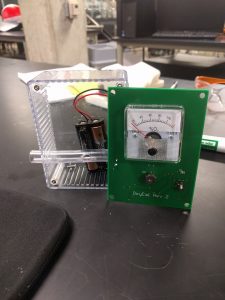In the third week of SEED, we finally got down to business. We began to assemble our prototype of the OxyCal, with all the materials that were left by the previous team for us (circuit boards, small surface mounted chips, and a plastic box).
Monday:
We realized that the research we had conducted was uncomprehensive, and we had jumped too fast into the next steps. We went back to the computer lab and performed research for the majority of the day. We found out:
- How oxygen concentrators work. The parts that they consist of and the major problems for why they lose calibration.
- How Zinc-Air batteries work, and the role that temperature, pressure, and oxygen concentration have on their voltage.
Tuesday:
This was our play day in the electronics room. We began by scavenging around for old circuit boards that had been thrown away. We then practiced the art of desoldering the integrated circuit components from the boards, and soldering them again by hand. Out of the corner of my eye, the reflow oven caught my eye, and I was determined to get this working over the next 24 hours.
The reflow oven works through a different technique than soldering by hand. Solder paste is applied to the pads of the Printed circuit board (PCB), and components are placed onto the solder paste. the solder paste holds the components onto it. The board is then placed in an oven (which reminds me of baking a cake). The oven preheats the entire board slowly, raising the temperature in an exactly linear manner as to not damage any parts in there. It holds it at a “solder” temperature, in which the solder paste melts, and connects the metal pads of the board to the legs of the circuit. This process avoids the chaos of hand soldering leg by leg, component by component. You just apply the solder paste, throw it in the oven, and crank the heat up.
There’ll probably be excess solder paste remaining, since the legs and pads are so small and can only absorb so much, but that’s OK. Put the solder wick on it and let the excess solder be sucked up.
In the afternoon, we underwent a 3D printing workshop with our TA, Jeremy. He taught us an introduction to SolidWorks, and then showed us how to configure and use the 3D printers.
At night, we went to meet with our client. We drove down to clear lake area for a nice dinner with Mr. Nishant Verma, which is now currently employed at LivaNova. He showed us some techniques for soldering, answered our questions about the circuit, and gave us lots of encouragement for the project.
Wednesday:
We worked all day to get our prototype to work. Assembling the circuit was difficult work for all of us.
Thursday and Friday:
We went into testing of the OxyCal circuit. We developed a plan for testing, and secured a Handi+, an current on-the-market oxygen calibrator. Our testing uncovered many more problems. The zinc-air batteries we had were uncalibrated (even though they were new!), and the older ones wouldn’t even respond to the oxygen readings. The pads on the circuit were also shorting out. We fixed these problems, as well as brainstormed some more permanent solutions to calibrate the batteries.
Friday night about half of us went on Critical Mass, a bike ride around Houston.
All in all, I learned many things this week. I also learned more about how to work with people from different cultures (since the rest of my team is international students), and how to show patience when working with them.


